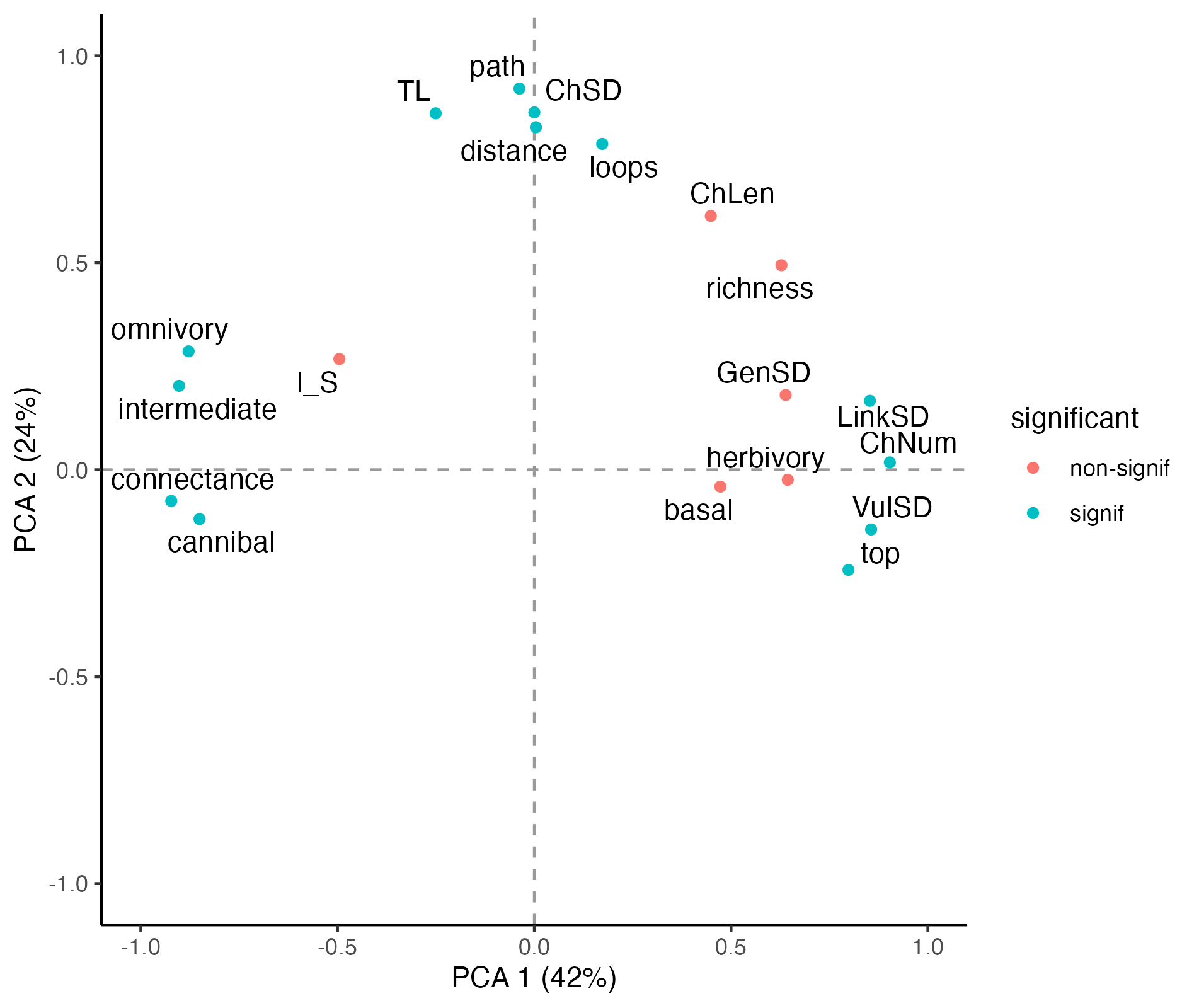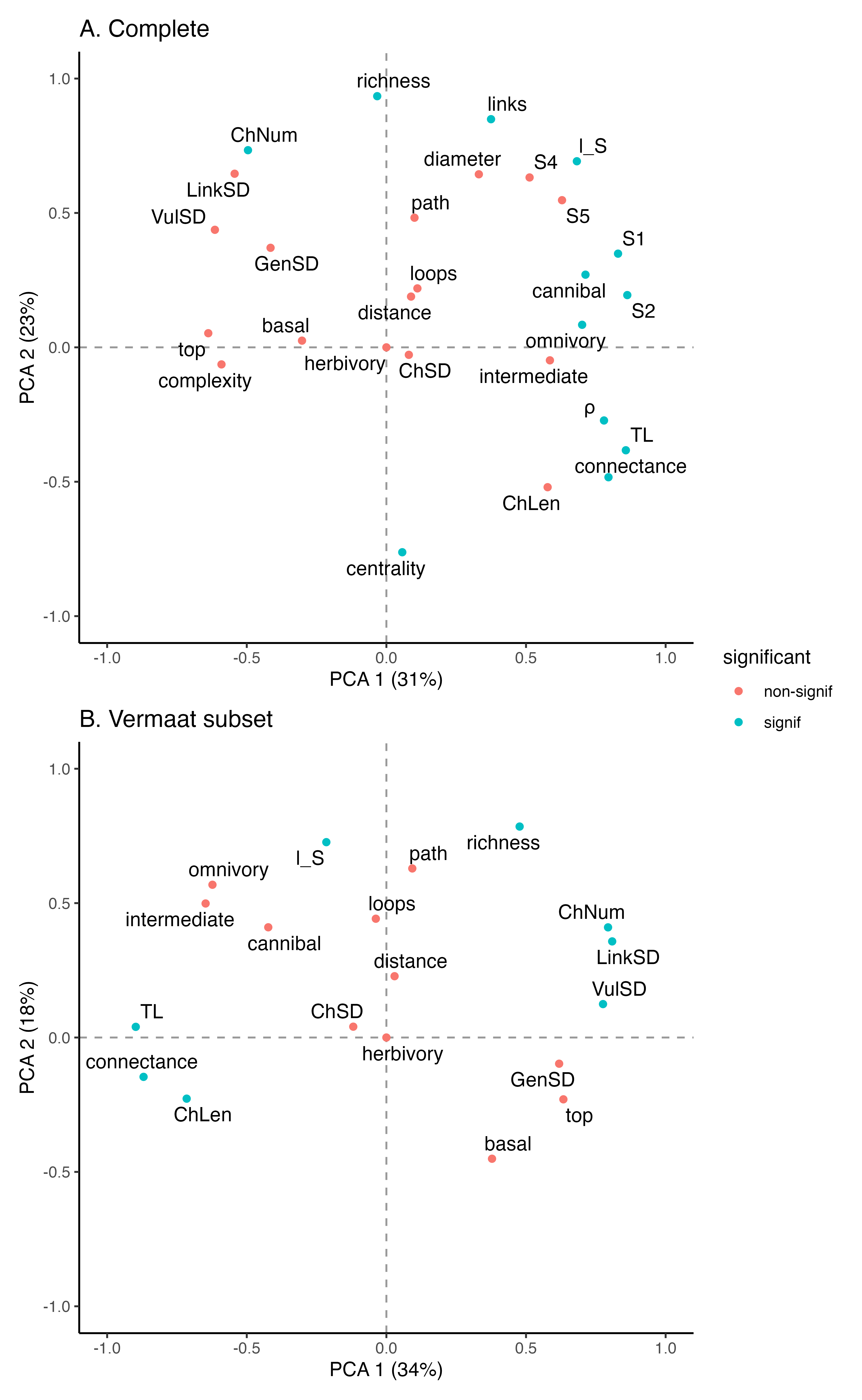| Basal |
Percentage of basal taxa, defined as species who have a vulnerability of zero |
|
|
| Connectance |
\(L/S^2\), where \(S\) is the number of species and \(L\) the number of links |
|
|
| Cannibal |
Percentage of species that are cannibals |
|
|
| ChLen |
Mean food chain length, averaged over all species (where a food chain is defined as a continuous path from a ‘basal’ to a ‘top’ species) |
|
|
| ChSD |
Standard deviation of ChLen |
|
|
| ChNum |
log number of food chains |
|
|
| Clust |
mean clustering coefficient (probability that two taxa linked to the same taxon are also linked) |
|
TODO |
| GenSD |
Normalized standard deviation of generality of a species standardized by \(L/S\) |
|
Williams and Martinez (2008) |
| Herbivore |
Percentage of herbivores plus detritivores (taxa that feed only on basal taxa) |
|
|
| Intermediate |
Percentage of intermediate taxa (with both consumers and resources) |
|
|
| LinkSD |
Normalized standard deviation of links (number of consumers plus resources per taxon) |
|
|
| Loop |
Percentage of taxa in loops (food chains in which a taxon occurs twice) |
|
|
| L/S |
links per species |
|
|
| MaxSim |
Mean of the maximum trophic similarity of each taxon to other taxa, the number of predators and prey shared by a pair of species divided by their total number of predators and prey |
|
TODO |
| Omnivory |
Percentage of omnivores (taxa that feed on \(\geq\) 2 taxa with different trophic levels) |
|
|
| Path |
characteristic path length, the mean shortest food chain length between species pairs |
|
|
| Richness |
Number of nodes in the network |
|
|
| TL |
Prey-weighted trophic level averaged across taxa |
|
Williams and Martinez (2004) |
| Top |
Percentage of top taxa (taxa without consumers) |
|
|
| VulSD |
Normalized standard deviation of vulnerability of a species standardized by \(L/S\) |
|
|
| Links |
The number of links in the network |
|
|
| Diameter |
Diameter can also be measured as the average of the distances between each pair of nodes in the network |
|
Delmas et al. (2019) |
| \(\rho\) |
Spectral radius is a a conceptual analog to nestedness (and more appropriate for unipartite networks). It is defined as the absolute value of the largest real part of the eigenvalues of the undirected adjacency matrix |
|
Staniczenko, Kopp, and Allesina (2013) |
| Complexity |
SVD complexity of a network, defined as the Pielou entropy of its singular values |
Something about structural v behavioural complexity being captured |
Strydom, Dalla Riva, and Poisot (2021) |
| Centrality |
Centrality is a measure of how ‘influential’ a species is, under various definitions of ‘influence’… |
Centrality can help in quantifying the importance of species in a network |
|
| S1 |
Number of linear chains |
|
Daniel B. Stouffer et al. (2007) Milo et al. (2002) |
| S2 |
Number of omnivory motifs |
|
Daniel B. Stouffer et al. (2007) Milo et al. (2002) |
| S4 |
Number of apparent competition motifs |
|
Daniel B. Stouffer et al. (2007) Milo et al. (2002) |
| S5 |
Number of direct competition motifs |
|
Daniel B. Stouffer et al. (2007) Milo et al. (2002) |
| Intervality |
The degree to which the prey in a food web can be ordered so that all species can be placed along a single dimension |
|
Daniel B. Stouffer, Camacho, and Amaral (2006) |
| Prey:predator |
Ratio of prey (basal + intermediate) to predators (top + intermediate) |
A measure of food web ‘shape’. Values <1 imply an inverted structure and might indicate instability |
|
| Robustness |
Minimum level of secondary extinction that occurs in response to a particular perturbation |
|
Jonsson et al. (2015) |

